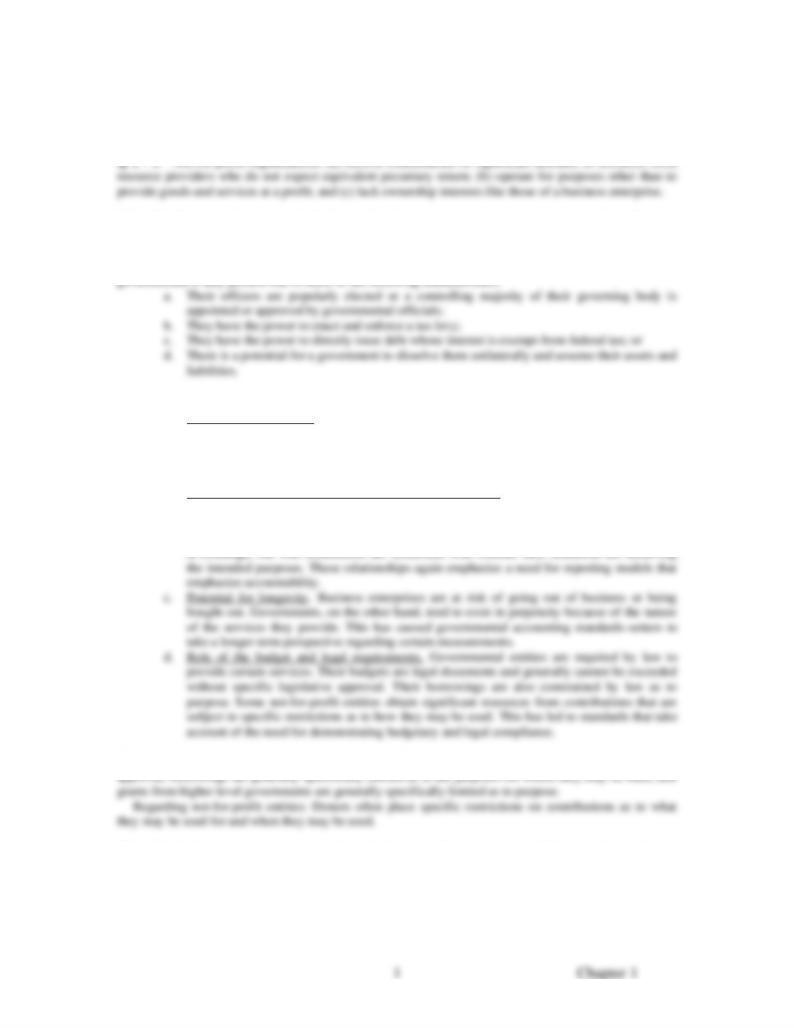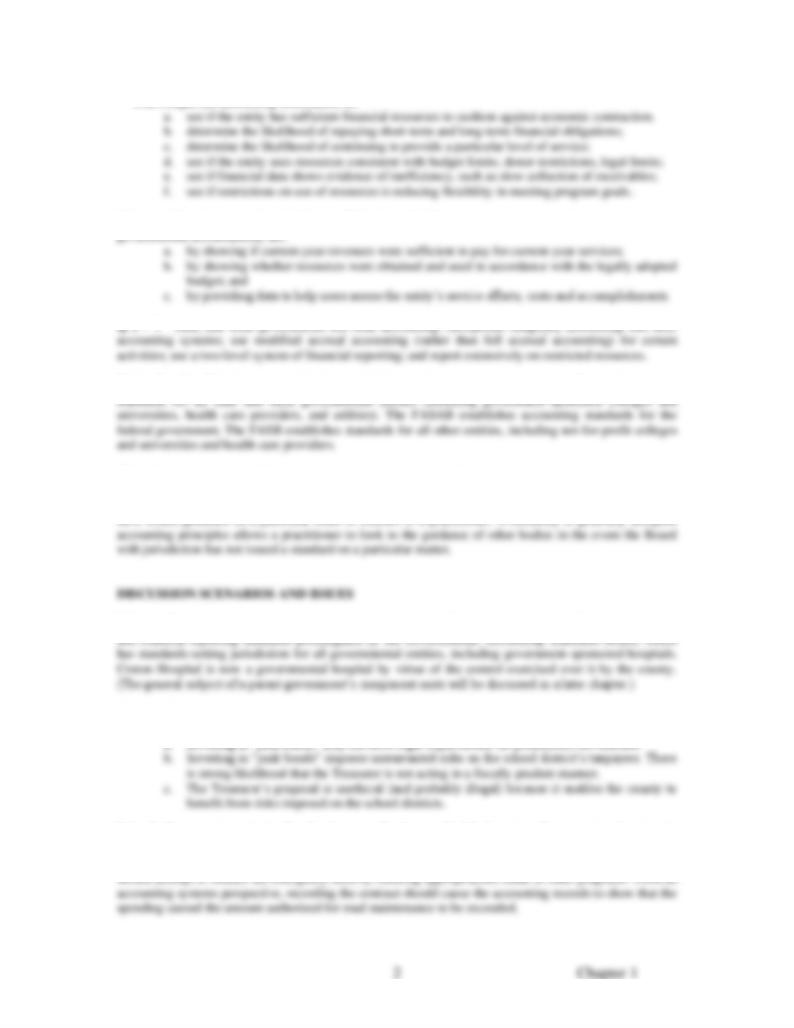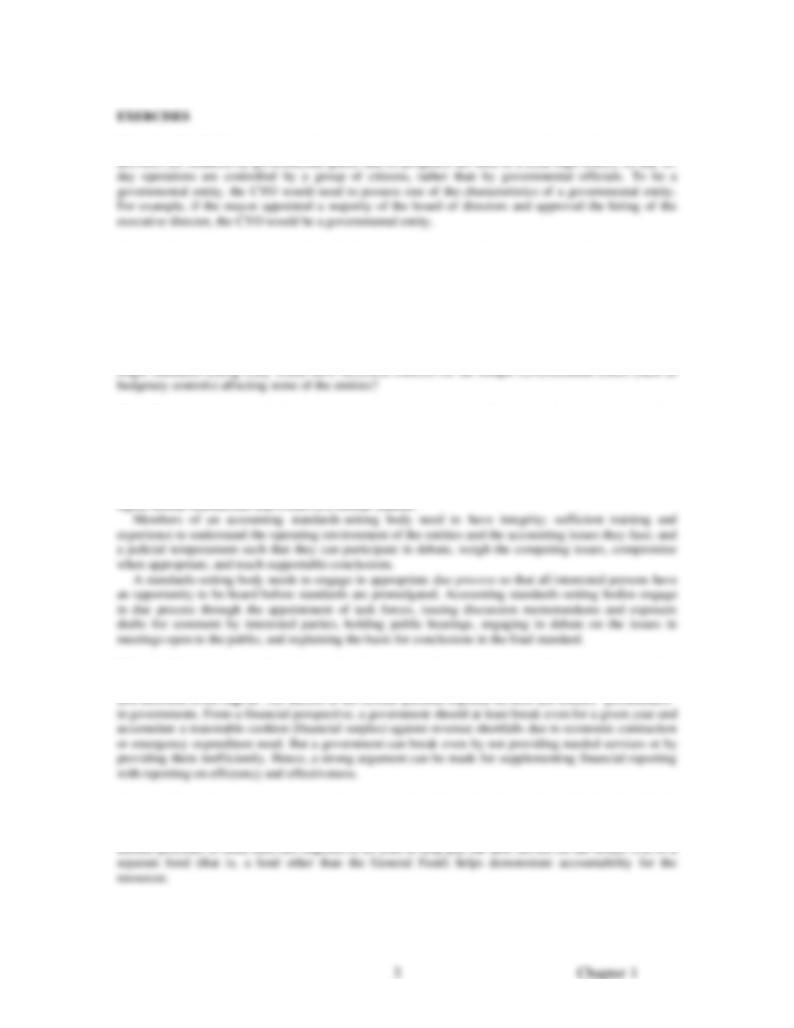
----------------------------------------------------------CHAPTER 1------------------------------------------------------
REVIEW QUESTIONS
Q 1 – 2 Governmental entities include: the federal government; general-purpose political subdivisions
(such as states, counties, cities, and towns); special-purpose political subdivisions (such as school districts);
and public corporations and bodies corporate and politic (such as state-operated toll roads and toll bridges).
Other organizations created by governments by statute or under not-for-profit corporation laws are
Q 1 – 3 Major environmental characteristics of governmental and not-for-profit organizations are:
a. Organizational purposes. Governmental and not-for-profit entities exist to provide services to
their constituents, not to generate profits. A reported excess of revenues over expenditures
does not mean that they have made a profit, have operated efficiently, or have served their
constituents effectively. Therefore, financial reporting for these entities requires an emphasis
on accountability.
b. Sources of revenue and relationship with stakeholders. Governments derive revenues
primarily from taxpayers. Individual taxpayers are involuntary resource providers whose tax
payments may or may not bear a direct relationship to the services they want or need. Not-
for-profit entities obtain significant resources from donors who receive no service or product
Q 1 – 4 Regarding government: Budgets generally cannot be exceeded without specific legislative
Q 1 – 5 Users of governmental and not-for-profit entity accounting information are both internal and
external. Major external users are:
a. Resource providers (taxpayers, donors and potential donors, investors and potential investors,
bond-rating agencies, and grant-providing organizations)
b. Oversight bodies (higher-level governments, regulatory bodies)
c. Service recipients (citizen advocate groups)

Users might use accounting information to:
Q 1 – 6 The three ways identified by the GASB in which financial reporting can assist users in assessing
Q 1 – 8 The GASB is responsible for establishing and improving accounting and financial reporting
Q 1 – 9 Accounting and financial reporting guidance is provided not only by the two major accounting
standards-setting bodies, but also by the AICPA, the staffs of the accounting standards-setting bodies, and
even professional literature. Because of the heavy workloads of the standards-setting bodies, they may not
D 1 – 1 The County comptroller should take the position that Croton Hospital must follow the accounting
D 1 – 2 This problem raises questions involving legal requirements, investment prudence and ethics. The
County Administrator should tell the Treasurer to drop his proposal for the following reasons:
D 1 – 3 The mayor’s action is illegal unless specifically provided for by city ordinance. Actually, there is
probably no reason the mayor could not have sought prior approval. From a financial perspective, the
$350,000 contract might cause the city to experience a deficit for the year; hence, if possible, the city

E 1 – 1 The CYO is a not-for-profit organization, rather than a governmental entity. Even though its
E 1 – 2 The major argument in favor of having a single body establish accounting and financial reporting
standards for hospitals is that it enables those interested in comparing financial performance among the
three hospitals to have reasonable assurance that similar transactions and events are reported in a similar
manner.
The major arguments in favor of having separate standards-setting bodies relate to issues of sovereignty
and environment. There is a fundamental issue concerning the way in which the members of a single
standards-setting body would be appointed. Would the governmental sovereignty issues be satisfied if all
the members of the standards-setting body were appointed by private sector persons? Is it likely that a
E 1 – 3 Accounting standards-setting bodies are needed to resolve differences of opinion regarding the
way in which specific transactions and events are accounted for and reported. Many accounting issues are
controversial and honest persons can disagree on the way in which they ought to be accounted for and
reported. The treatment of pledges is an example of such an issue. A standards-setting body, with
appropriate authority, can develop a single solution even though not everyone may agree with it. This
enables financial statement users to have reasonable assurance that all not-for-profit organizations will
E 1 – 4 Without accruing for items applicable to a particular year, but not paid in that year, one cannot
demonstrate whether “current year revenues were sufficient to pay for current-year services.” Hence, the
E 1 –5 The village manager’s instructions are probably illegal. The proposition explicitly requires the
bond proceeds to be used for building a new fire house. Statutes generally provide for disposition of
proceeds from bond sales that were not needed for the purposes for which the bonds were sold. Very often,